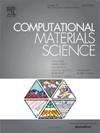Revealing the tensile anisotropic mechanisms of additive manufactured IN718 alloy based on crystal plasticity modeling
IF 3.1
3区 材料科学
Q2 MATERIALS SCIENCE, MULTIDISCIPLINARY
引用次数: 0
Abstract
The mechanical behavior of IN718 alloy produced by additive manufacturing (AM) displays significant anisotropy due to its unique microstructure, which differs markedly from conventionally manufactured materials. This study focuses on understanding the tensile anisotropy of AM IN718 alloy by employing a crystal plasticity approach. Grain boundary strengthening is modeled through the Hall-Petch relationship, and a modified dislocation mean free path model is incorporated to account for the grain size effect. These models are applied to simulate the influence of grain morphology (columnar and equiaxed grains) and crystallographic texture on the tensile response of AM IN718 alloy. The results reveal that columnar grains and texture affect both yield strength and strain-hardening behavior. Columnar grains, aligned along the build direction, induce significant variations in yield strength and strain-hardening due to differences in effective grain size in different loading directions. Texture can also affect the strain-hardening behavior by influencing the dislocation multiplication. The study offers a qualitative assessment of how grain morphology and crystallographic orientation govern the anisotropic behavior of AM IN718 alloy, providing insights that can guide the optimization of mechanical properties in AM-produced components.

求助全文
约1分钟内获得全文
求助全文
来源期刊

Computational Materials Science
工程技术-材料科学:综合
CiteScore
6.50
自引率
6.10%
发文量
665
审稿时长
26 days
期刊介绍:
The goal of Computational Materials Science is to report on results that provide new or unique insights into, or significantly expand our understanding of, the properties of materials or phenomena associated with their design, synthesis, processing, characterization, and utilization. To be relevant to the journal, the results should be applied or applicable to specific material systems that are discussed within the submission.
 求助内容:
求助内容: 应助结果提醒方式:
应助结果提醒方式:


